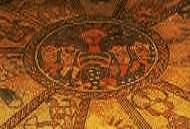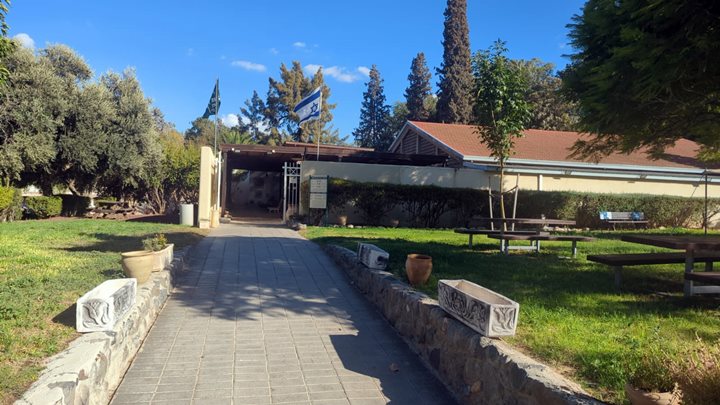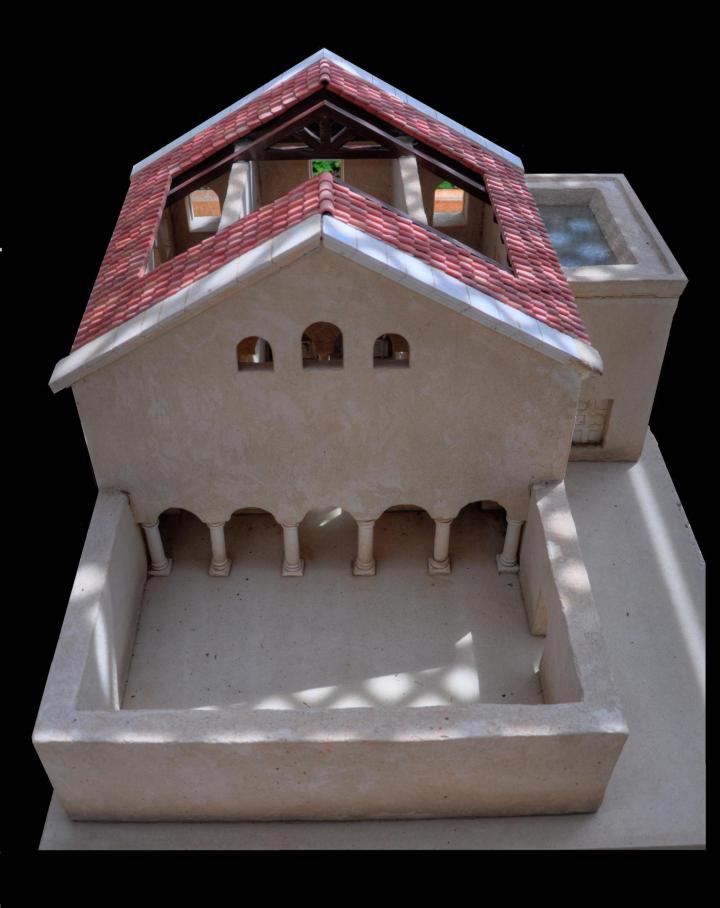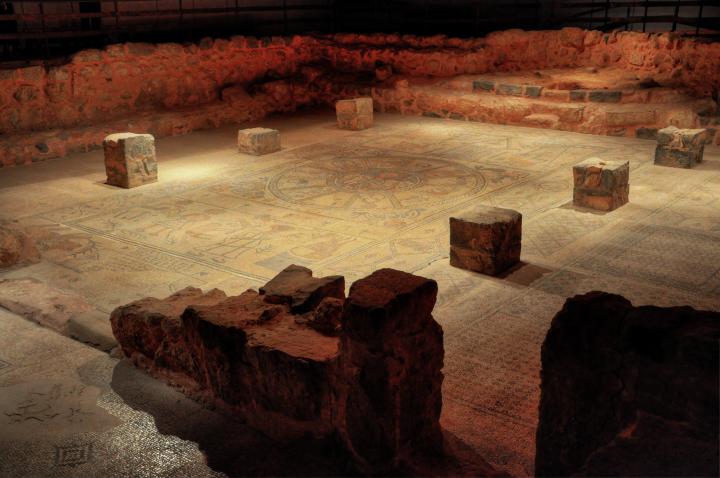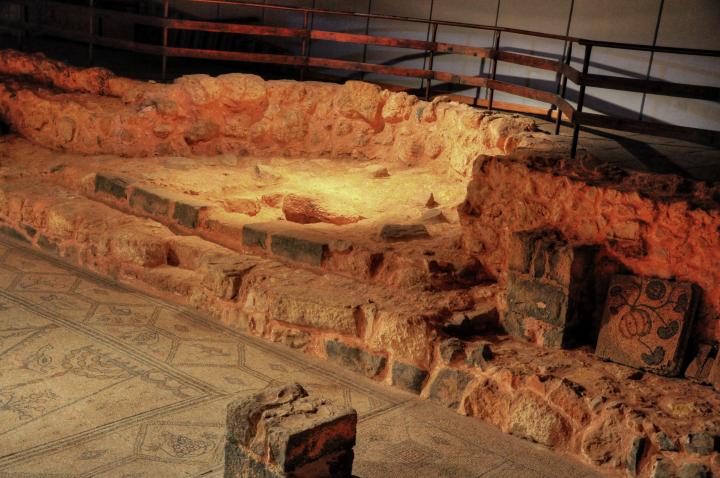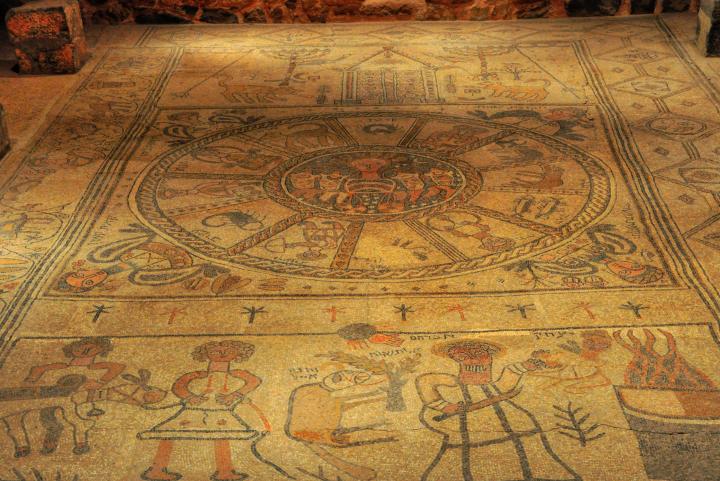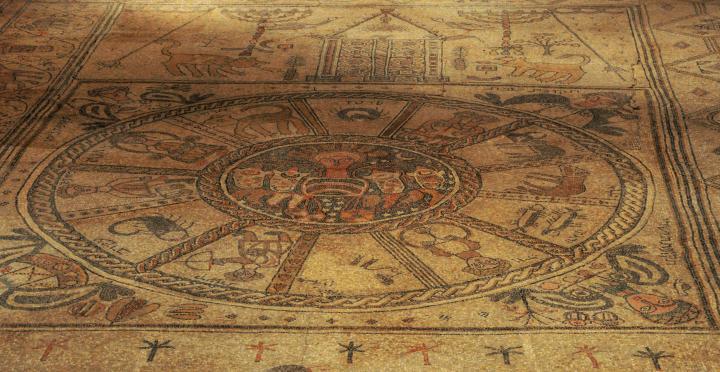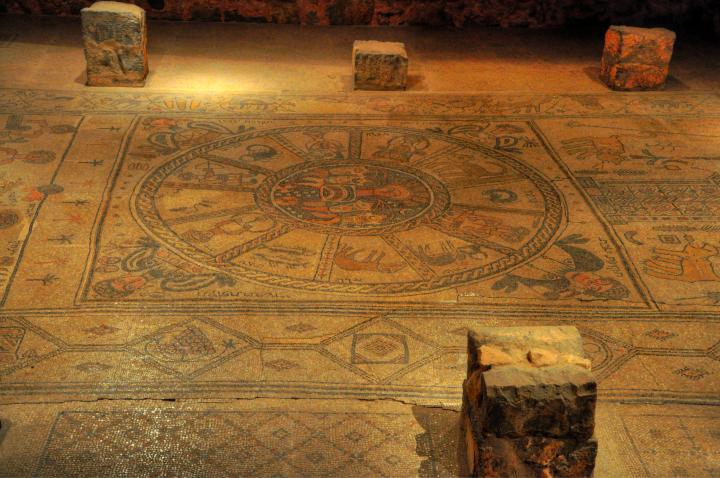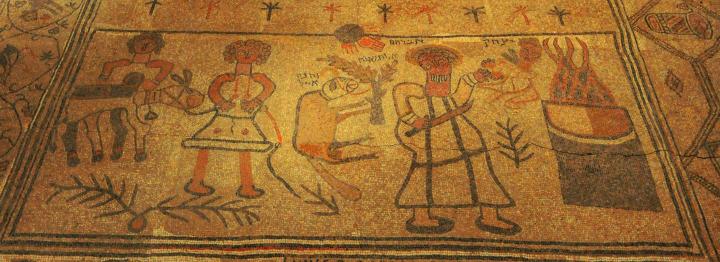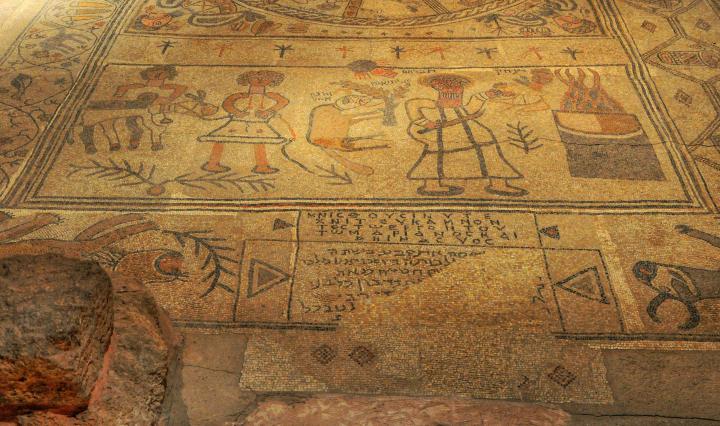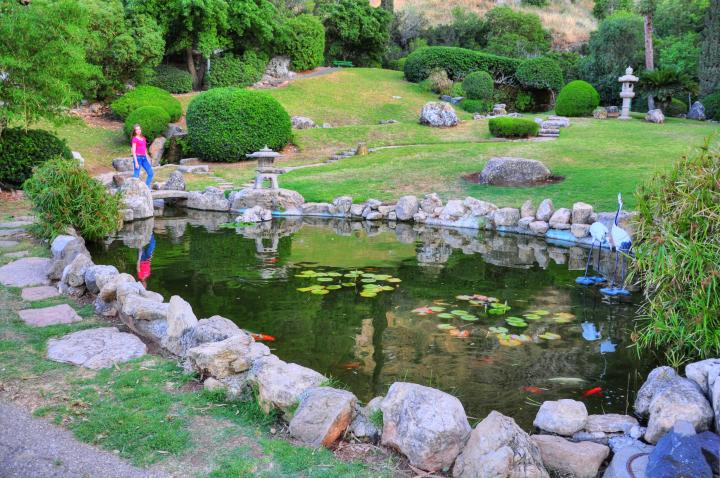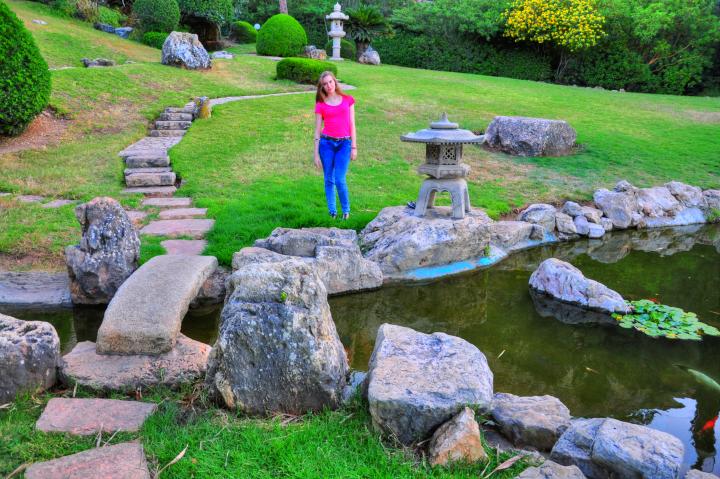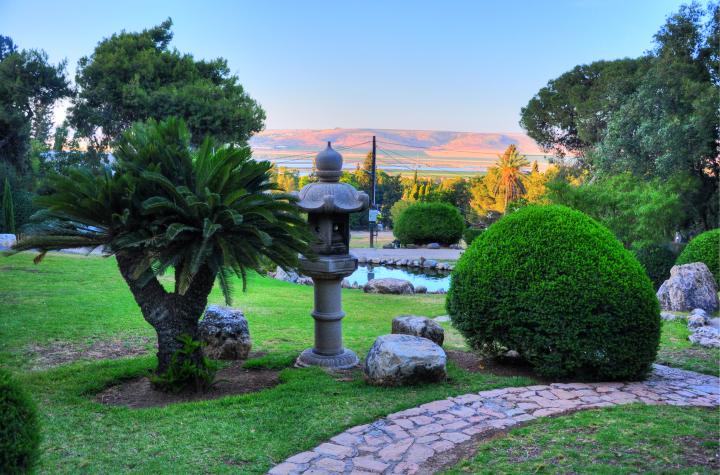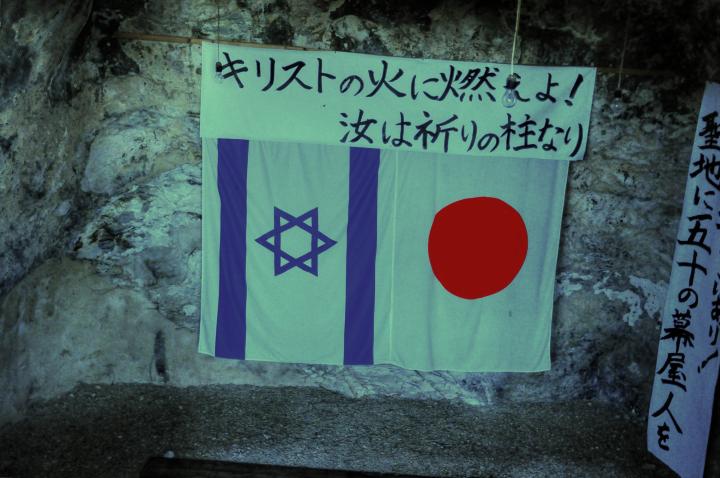An ancient synagogue from the Byzantine period, where a beautiful mosaic floor was found, illustrating a Zodiac, the Ark, and the binding of Isaac. Nearby, a center of the Makuya Japanese movement.
Home > Sites > Yizreel Valley > Beit-Alpha and Hefzi-Bah
Contents:
Background
Location
History
Photos
* Museum
* The Plan
* Interior
* Mosaic
* Japanese Garden
References
Etymology
Background:
The ancient synagogue of Beit Alpha, dated to the Byzantine period, was a 20m x 14M building. It was covered across its entire floor by a magnificent colorful mosaic floor. The mosaic floor, which was very well preserved, includes a Zodiac , Jewish ritual objects and the ark, two inscriptions in Greek and Aramaic, geometric patterns and icons of animals, birds, plants and fruits, and a scene from the Biblical story of the binding of Isaac.
Location:
The ancient synagogue is housed in a modern structure which was built over the floor in order to protect it, and is open to the public. This national park is located between the two modern Kibbutz of Beit-Alpha and Hefzi-Bah. The visitors entrance is through a parking area located inside Kibbutz Hefzi-Bah.
On the highest point in Kibbutz Hefzi-Bah, on the foothills of Mt. Giboa, is a small Japanese garden and a learning center of the Makuya Christian movement.
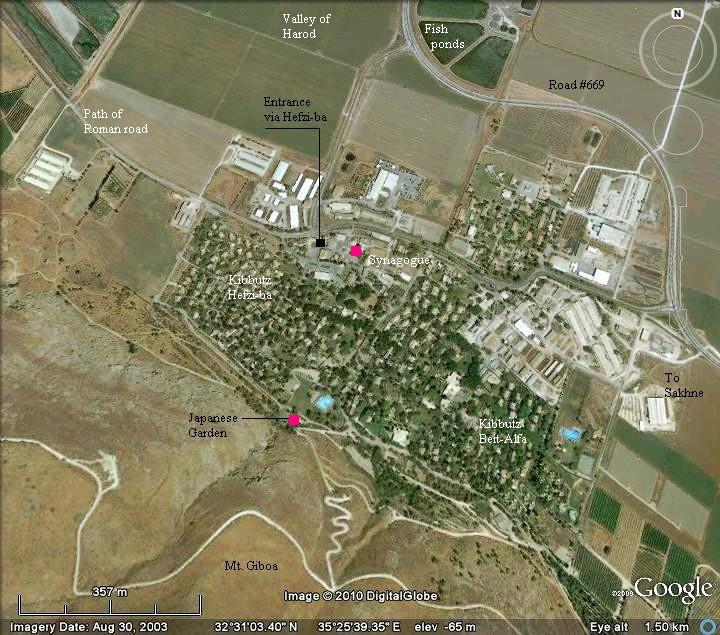
History:
- Persian/Hellenistic period
Ruins of a Persian/Hellenistic period settlement, known as Horvat Shamot (Tell el-Firr), are buried in the field between Hefzibah and Beit HaShitta, 2km north-north-east of the ancient synagogue. The site was totally leveled in 1960, but fragments of an important stele were found and assembled after it was razed by a local farmer. The limestone stele measures 77 x 47 cm and 16cm deep.
The inscription features a transcript of correspondence between Antiochus III (223–187 BCE) and Ptolemy son of Thraseas. It is a significant artifact that sheds light on the diplomatic and political interactions during the Hellenistic period. This inscription, written in Greek, provides valuable insights into the communication and relations between the Seleucid Empire and other Hellenistic states.
Antiochus III, also known as Antiochus the Great, was a ruler of the Seleucid Empire and is known for his attempts to consolidate and expand his territory. Ptolemy son of Thraseas was a notable figure under the Ptolemaic dynasty, possibly holding a significant administrative or military position. The documents belong to various stages of the 5th Syrian war.
The inscription is essentially a letter or series of letters exchanged between Antiochus III and Ptolemy. The content typically revolves around diplomatic matters, military campaigns, and administrative issues. The correspondence highlights the diplomatic efforts to maintain or negotiate peace, alliances, or territorial agreements. It includes discussions about military movements, strategies, or support in ongoing conflicts may be present. Furthermore, it relates to issues of governance, taxation, or regional administration could be addressed.
-
Roman/Byzantine period
Beit-Alpha was a small Roman/Byzantine agriculture village, situated at the northern foothills of Mt. Giboa. It was located near the Roman road from Scythopolis (Beit She’an) to Megiddo/Legion and Caesarea.
The village is marked (with a yellow circle) on a section of the Peutinger map (Peutingeriana tabula), which is based on a Roman map of the 4th century Imperial Roman roads. Note that the map is inverted with the west on top. On the east end is “Scytopoli”, and on the west side is Caperconti (Legion near Megiddo) and then Caesarea Maritama (“Cesaria”).
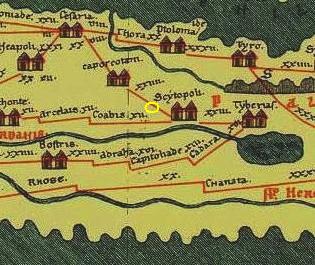
Traces of the Roman/Byzantine ruins were found around the ancient synagogue. These ruins were partially excavated in 1962, but the area around the site is populated by modern structures of Kibbutz Hefzi-Ba. Walking around the ancient synagogue you can still notice fragments of ceramics around the site, but basically nothing remained except for the beautiful mosaic floor and parts of the structure.
The village was established during the 1st century AD or so. The synagogue itself was built at the end of the 5th century, while its mosaic floor was commissioned during the beginning of the 6th century, at the times of Byzantine emperor Justine I (reigned 518-527 AD). The artists who are named in the mosaic inscription – Marianos and his son Hanina – are the same mosaic craftsmen of the nearby city of Beit She’an. A hoard of Byzantine coins, dated to the beginning of the 4th century, were hidden in a Genizah (ritual archive place) under the apse.
-
Later periods
The synagogue continued to function under Arab control, but was destroyed in the massive earthquake of 749 AD which leveled many of the towns and cities in the region. It remained in ruins until the 20th century.
Under the Arab control, and later the Mameluk and Ottoman periods, the water channels and irrigation of the area were not repaired ever since the great earthquake. Soon enough, the whole basin of the Harod valley, between Afula and Beit She’an, turned into one big swamp. This prevented any use of the land, so the region remained deserted until the Jewish resettlement of the Jezreel valley in the 1920s.
The site was examined in the PEF survey (1866-1877) by Wilson, Conder and Kitchener. It appears as “Kh. Beit Ilfa” in the center of the section of this map of 1878. They described it as “Foundations of buildings and walls. There are in the ruins many stones well dressed, and apparently older than the Arabic work”. They added “Guerin found, a little to the right of the ruined and abandoned village, numerous heaps of stones, the greater part of fair dimensions, and dispersed in the midst of high thorn-bushes. Among these remains were noted also two ancient sarcophagi, each measuring 9’10” long by 3’3″ broad, decorated by rare ornaments…”.
Part of Map sheet 9 of Survey of Western Palestine,
by Conder and Kitchener, 1872-1877.
(Published 1880, reprinted LifeintheHolyLand.com)
The site is situated near two ancient Roads – marked by a single dashed line (below it, going from Beth She’an to Megiddo) and one at the bottom of the section which is marked by a double dashed line (going thru Fakouah to Jenin).
-
Modern times
Two Kibbutz settlements were established in 1922 around the ruins of the Roman village, a place known as Khirbet Beit-Ilfa. The Kibbutz on the east side was named after the ruins – “Beit-Alpha”. The Kibbutz on the west was named “Hefzi-bah”, which is one of the Biblical names of Jerusalem.
The mosaic was discovered in 1928 by the settlers during the development of the area. The excavations were managed by E.L. Sukenik in 1929, the famous archaeologist who acquired the Dead Sea scrolls and the father of the renowned archaeologist/general Yigal Yadin. The picture below (courtesy of the museum) shows the professor directing the dig, standing on the right side of the dig.
The discovery and the dig was an important event for the Zionist movement – the first ancient synagogue excavated by a Jewish archaeologist in the newly founded land.
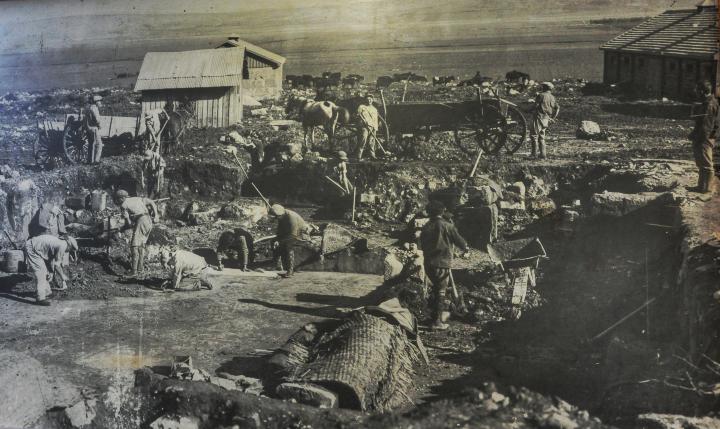
Today the site is a national park and is a recommended place for a short one-hour stop. An audiovisual presentation shows a humorous play of the process of the commissioning of the mosaic, which is projected around and over the mosaic floor.
Photos:
(a) The Museum
The antiquities are located in Beit Alpha antiquities National park. It is accessed from the adjacent Kibbutz Hefzibah. The site has a visitor center where an audiovisual presentation explains the historical and cultural context of the synagogue and its mosaic floor, providing insight into the Byzantine period and Jewish life in the area. The main attraction is the remains of a Byzantine-era synagogue dating back to the 6th century AD. The synagogue was part of a Jewish farming community.
(b) Plan of the Synagogue
A reconstruction of the Synagogue is seen in the model which is located near the museum’s entrance. This was a two-story rectangular structure, facing south-west towards Jerusalem. The roof was entirely covered by ceramic tiles. The upper level probably had functioned as the women’s wing, and stairs led to it from the right (west) room.
An open courtyard (atrium, 10m wide x 7m long) is reached from the street, with an opening on the western side of the courtyard wall. The courtyard is paved with mosaics, decorated with geometric patterns. On its south side is a covered narthex (2.5m long), which leads via three doorways into the inner prayer hall.
Click on the photos to view in higher resolution…
(c) Interior
The prayer hall (10m wide x 8m long) consists of a central nave and two side aisles, separated by eight stone pillars, which are seen in the photo. The entire floor in the prayer room is covered with a colorful decorated mosaic, with the main paintings and inscriptions arranged along the central nave. The floor of the western aisle is decorated with geometric patterns, while the eastern aisle is paved with undecorated white stone.
A rounded raised recess (2.4m deep) on the south side of the synagogue is where the ark stood. There are three steps leading up from the floor.
(d) Central Nave
The synagogue’s floor features a beautiful and detailed mosaic that is remarkably well-preserved. The mosaic is divided into three main panels:
- The Ark of the Covenant: Depicted with Jewish ritual objects like menorahs and shofars. It is on the south side, seen on the top of the photo below, near the raised recess.
- The Zodiac Wheel: A striking panel showing the 12 zodiac signs, surrounded by Helios, the sun god, in a chariot. It is in the center of the floor.
- The Binding of Isaac (Akedah): A Biblical scene illustrating the moment when Abraham is about to sacrifice Isaac. It is in the north side, at the bottom of the photo.
Around these three panels are geometric patterns, with paintings of animals, birds, plants and fruits.
These three panels are detailed below.
-
South panel – Ark and ritual elements
The upper (southern) section of the mosaic was close to the holiest section of the synagogue. Therefore, this panel has the Jewish religious illustrations, with the Torah ark in its center. This design is also common to other ancient synagogues in the region.
The covered ark is located under a roof, two ostriches flanking the edge of the roof, and the eternal flame in the center. A candelabrum and a lion are depicted on each of its sides, and other ritual objects appear around it (ram’s horn, palm branch, citron fruit and incense shovel).
- Center panel – Zodiac
The center of the Zodiac is seen below, which symbols the cycle of Nature. In this scene is Helius, the Greek God of the Sun, ascending from the sea on a carriage pulled by4 horses. Around the center of the zodiac are twelve signs of the Zodiac, with their Hebrew names.
Helios was the Titan god of the sun who presided over the the measurement and divisions of the day, the year and the seasons. It was a common motif in ancient synagogues in Israel, where 7 sites (Sepphoris, Hammat-Tiberias, Yafia, Khirbet Susiya, Beth She’an, Naaran and Husifa) illustrated the twelve zodiac signs with Helios in a sun chariot, most of them surrounded by angels. Although this is a Jewish synagogue, these pagan symbols were common at that period and used only for decorative purposes.
Another view of the zodiac in the center of the floor:
-
North panel – The binding of Isaac
The mosaic section in the panel below the zodiac illustrates the Biblical story of the sacrifice of Isaac by Abraham. This is also common to other synagogue floors.
The two young men depicted on the left were part of the story, when Abraham told his men to wait with the donkey, as seen in this painting (Genesis 22:16-17): “And Abraham said unto his young men, Abide ye here with the ass; and I and the lad will go yonder and worship, and come again to you.” On the right side is a part of the scene of Abraham and Isaac at the place of the altar, with their names in Hebrew (Isaac, Abraham). In the center is a lamb that replaced Isaac as a sacrifice (Genesis 22: 13): “And Abraham lifted up his eyes, and looked, and behold behind him a ram caught in a thicket by his horns: and Abraham went and took the ram, and offered him up for a burnt offering in the stead of his son”.
Under the illustration are two inscriptions. The upper Greek inscription (5 rows) names the artists, while the lower Aramaic inscription (7 rows, partially damaged) names the donors and describes the time of the mosaic’s commissioning (Justine).
The paintings look naive and primitive. If compared to the Zodiac mosaics in Hammat Tiberias or Sepphoris, they look like a they were copied from these synagogues. However, they do present a magnificent and colorful setting for the synagogue.
(e) Japanese Garden in Hefzi-Bah
Makuya (Japanese for Mishkan – the Holy Tabernacle – God’s dwelling place) is a Japanese Christian religious movement which identifies intensely with the state of Israel and its people. It was founded in 1948 by the late professor Ikurō Teshima (1910-1973).
A charming Japanese garden is located on the highest point in Kibbutz Hefzi-Ba, close to the cliffs of Mt. Gilboa, and is open to the public. It was planned by the Makuya’s founder as a symbol of Japanese culture and appreciation to the Israeli pioneering.
Built in 1975, the garden was constructed in the spirit of the Biblical prophecy (Isaiah 41:18-20): “I will open rivers in high places, and fountains in the midst of the valleys: I will make the wilderness a pool of water, and the dry land springs of water. I will plant in the wilderness the cedar, the shittah tree, and the myrtle, and the oil tree; I will set in the desert the fir tree, and the pine, and the box tree together: That they may see, and know, and consider, and understand together, that the hand of the LORD hath done this, and the Holy One of Israel hath created it”. Indeed, this garden, and the people of Israel, materializes this prophecy.
From the garden are great views of the area, since the garden is located at the highest point in the Kibbutz.
In the background of the photo below you can see, behind the bushes, the southern side of Ramot Naftali (Naphtali heights) and the fish ponds in the valley of Harod.
Note that this garden is on private property of the Kibbutz. Visits are required to be coordinated with the public relations person in charge of tours (see links for details).
In a small cave above the garden, embedded into the cliffs of Mt Gilboa, the Makuya have a private praying shrine. This cave is a Roman/Byzantine period cistern, which supplied water to the village.
The Makuya movement sends its youths to Kibbutz settlements in Israel, and their primary stay is in Kibbutz Hefzi-Ba, where they have a Hebrew learning center (Ulpan). The Japanese youths are warmly accepted and hosted by the members of the Kibbutz. Webmaster Rotem’s Uncle Ronnie and Aunt Aviva, who are members of the Kibbutz, frequently invite their “adapted” Makuya youths to their home. They, and other youths of Hefzi-Ba, were invited to participate in the summer of 2010 to the Makuya international conference in Kumamoto, Japan, and to a special bi-national concert in Tokyo (picture below: singer Hanan Yovel; ambassador of Israel and his staff; Makuya member) .
Links and References:
* Beit Alpha:
- Bet alfa Antiques National park – Israel Nature and Parks authority
* Mosaic:
-
Mosaics BibleWalks info page
* Zodiac:
-
Hammat Tiberias in BibleWalks sites
-
Sepphoris in Biblewalks sites
-
Astrology and Judaism in Late Antiquity (broken link)
-
Helios – the Sun God
* Makuya:
-
“Secret of the Japanese Garden” – tour coordinator: Na’ama Amit,
* Other:
- A Greek inscription found near Hefzibah – Y. H. Landua; Israel exploration Journal, Vol 16, No 1 1966
-
Earthquakes in the Holy Land BibleWalks info
- “100 years of settlement – 100 years of coins” – coins found around the site – Ayelet Keidar Goldberg, 2020 (Hebrew)
Etymology (behind the name):
- Beit Alpha – Hebrew: Beit is “house”. Alpha is the first Greek letter, and was a private name used in the Greek and Roman times (Alpha is common name in the Talmud). Therefore, the name means “the House of Alpha”.
- Khirbet Beit Ilfa – the ruins of the Roman/Byzantine town (appears in the 1881-3 map of the PEF survey). The Arabic name of the ruins preserved the ancient Roman name.
- Kibbutz Beit Alpha – The Kibbutz was established in 1922. It is named after the ancient site.
- Hefzi-ba (Hephzi-bah) – The Kibbutz on the west side of the ancient synagogue was established in 1922. It is a female Hebrew name and means: “I desire her”, which refers to the love of Jerusalem (and is one of the city’s names). Biblical reference: Isaiah 62 4: “Thou shalt no more be termed Forsaken; neither shall thy land any more be termed Desolate: but thou shalt be called Hephzibah, and thy land Beulah: for the LORD delighteth in thee, and thy land shall be married.”
Note that are places in Israel are named Hefzi-ba, such as near Hadera.
BibleWalks.com – armchair tours of the Bible places
Tell Yizreel <<<—previous site—<<< All Sites>>>—next site—->>> Beit Shean
This page was last updated on Oct 4, 2024 (add photo of museum, add text)
Sponsored links:
